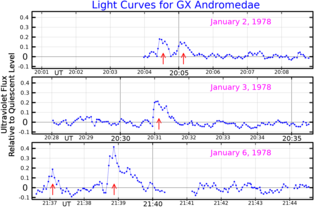
Groombridge 34 is a binary star system in the northern constellation of Andromeda. It was listed as entry number 34 in A Catalogue of Circumpolar Stars, published posthumously in 1838 by British astronomer Stephen Groombridge. Based upon parallax measurements taken by the Gaia spacecraft, the system is located about 11.6 light-years from the Sun. This positions the pair among the nearest stars to the Solar System.
Gliese 1 is a red dwarf in the constellation Sculptor, which is found in the southern celestial hemisphere. It is one of the closest stars to the Sun, at a distance of 14.2 light years. Because of its proximity to the Earth it is a frequent object of study and much is known about its physical properties and composition. However, with an apparent magnitude of about 8.6 it is too faint to be seen with the naked eye.
Gliese 674(GJ 674) is a small red dwarf star with an exoplanetary companion in the southern constellation of Ara. It is too faint to be visible to the naked eye, having an apparent visual magnitude of 9.38 and an absolute magnitude of 11.09. The system is located at a distance of 14.85 light-years from the Sun based on parallax measurements, but is drifting closer with a radial velocity of −2.9 km/s. It is a candidate member of the 200 million year old Castor stream of co-moving stars.

9 Aurigae is a star system in Auriga (constellation). It has an apparent magnitude of about 5, making it visible to the naked eye in many suburban skies. Parallax estimates made by the Hipparcos spacecraft put it at about 86 light-years from the solar system, although individual Gaia Data Release 3 parallaxes place all three components at 88 light years.
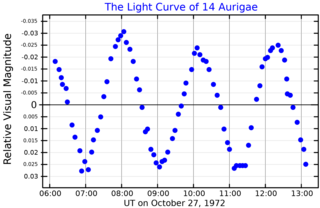
14 Aurigae is a quadruple star system located 269 light years away from the Sun in the zodiac constellation of Auriga. It has the variable star designation KW Aurigae, whereas 14 Aurigae is the Flamsteed designation. It is visible to the naked eye as a faint, white-hued star with a combined apparent visual magnitude of 5.01. The system is moving closer to the Sun with a heliocentric radial velocity of −9 km/s.
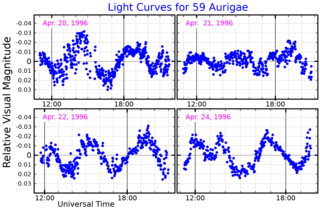
59 Aurigae, often abbreviated as 59 Aur, is a star in the constellation Auriga. Its baseline apparent magnitude is 6.1, meaning it can just barely be seen with the naked eye as a dim, yellow-white hued star. Based on parallax measurements, it is located about 483 light-years away from the Sun.
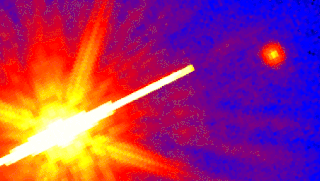
Gliese 105 is a triple star system in the constellation of Cetus. It is located relatively near the Sun at a distance of 23.6 light-years. Despite this, even the brightest component is barely visible with the unaided eye (see Bortle scale). No planets have yet been detected around any of the stars in this system.
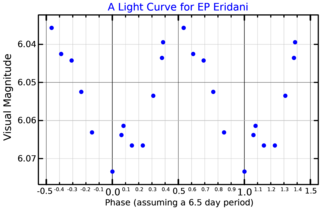
HD 17925 is a variable star in the equatorial constellation of Eridanus. It has the Gould designation 32 G. Eridani and the variable star designation EP Eri. The star has a yellow-orange hue and is dimly visible to the naked eye in good seeing conditions with an apparent visual magnitude that varies from 6.03 down to 6.08. It is located nearby at a distance of 34 light years from the Sun based on parallax, and is drifting further away with a radial velocity of +18 km/s. It is a likely member of the Local Association of nearby, co-moving stars. The spectrum shows a strong abundance of lithium, indicating that it is young star. This likely makes its point of origin the nearby Scorpio–Centaurus Complex.

Ross 458, also referred to as DT Virginis, is a binary star system in the constellation of Virgo. It has an apparent visual magnitude of 9.79 and is located at a distance of 37.6 light-years from the Sun. Both of the stars are low-mass red dwarfs with at least one of them being a flare star. This binary system has a circumbinary sub-stellar companion.
AM Canum Venaticorum is a hydrogen-deficient cataclysmic variable binary star in the constellation of Canes Venatici. It is the type star of its class of variables, the AM Canum Venaticorum stars. The system consists of a white dwarf gaining matter via an accretion disk from a semi-degenerate or white dwarf companion.
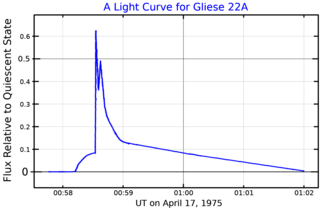
Gliese 22, also catalogued V547 Cassiopeiae or ADS 440, is a hierarchical star system approximately 33 light-years away in the constellation of Cassiopeia. The system consists of pair of red dwarf stars, Gliese 22A and Gliese 22C, orbited by a third red dwarf Gliese 22B in an outer orbit of about 223 years.

IQ Aurigae is a single, variable star in the northern constellation of Auriga. It is visible to the naked eye as a dim, white-hued star with an apparent visual magnitude that fluctuates around 5.38. The star is located at a distance of about 460 light-years from the Sun based on parallax and is drifting further away with a radial velocity of +28.6 km/s.
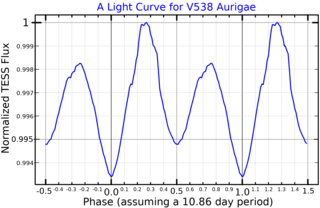
V538 Aurigae is a single star in the northern constellation of Auriga. With an apparent visual magnitude of 6.23, this star requires good dark sky conditions to view with the naked eye. It is located at a distance of 40.0 light-years (12.3 pc) from Sun based on parallax. The star is drifting further away with a radial velocity of 0.9 km/s. It is a member of the Local Association, and is most likely a thin disk star.
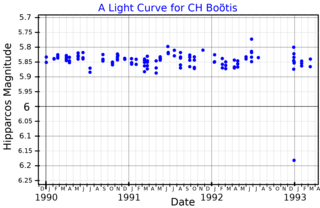
HD 128333 or CH Boötis is an irregular variable star in the northern constellation of Boötes. With an apparent magnitude of 5.7, it is faintly visibly to the naked eye under good observing conditions.

22 Vulpeculae is a binary star system in the northern constellation Vulpecula. Based on its parallax, it is located some 1,490 light-years away, and it has an apparent magnitude of about 5.2, making it visible to the naked eye. The system is moving closer to the Earth with a heliocentric radial velocity of −23 km/s.
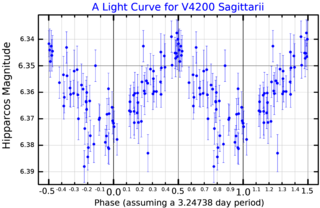
HR 7578 is a triple star system in the constellation of Sagittarius. Their combined apparent magnitude is 6.18. Parallax measurements by the Gaia spacecraft put the system at 46 light-years away, making this a nearby system.
Gliese 251, also known as HIP 33226 or HD 265866, is a star located about 18 light years away from the Solar System. Located in the constellation of Gemini, it is the nearest star in this constellation. It is located near the boundary with Auriga, 49 arcminutes away from the bright star Theta Geminorum; due to its apparent magnitude of +9.89 it cannot be observed with the naked eye. The closest star to Gliese 251 is QY Aurigae, which is located 3.5 light years away.
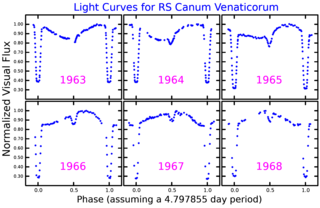
RS Canum Venaticorum is a binary star system in the northern constellation of Canes Venatici. It serves as the prototype to the class of RS Canum Venaticorum variables. The peak apparent visual magnitude of this system is below the level needed to observe it with the naked eye. It is located at a distance of approximately 443 light years from the Sun based on parallax, but is drifting closer with a net radial velocity of −14 km/s. Olin J. Eggen (1991) included this system as a member of the IC 2391 supercluster, but it was later excluded.
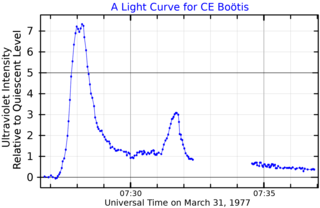
Gliese 569 is a ternary star system composed of a main-sequence star orbited by a pair of brown dwarfs in the constellation of Boötes about 32 light years away.

39 Ceti, also known as AY Ceti, is a star about 244 light years from Earth in the constellation Cetus. It is a 5th magnitude star, making it faintly visible to the naked eye of an observer far from city lights. AY Ceti is an RS Canum Venaticorum variable star, varying in brightness from magnitude 5.35 to 5.58 over a period of about 77 days.

















